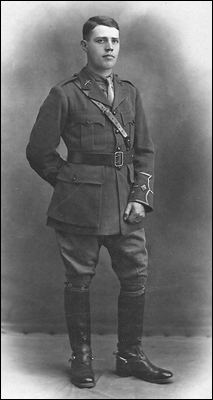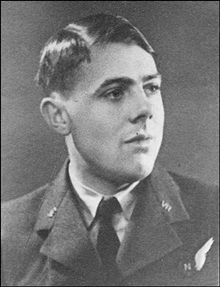|
Albert Victor COOK (1891-1973) |
| Albert Victor COOK was born on 6 July 1891, in the family home at 21 Ware Street,
Hoxton, in the county of London. He was the second eldest of six surviving children born to William Alfred and Sarah COOK née
HAUTOT, six other siblings having died in infancy. He was educated at St Columba's Boys School in Kingsland Road, London N, from 1896 to 1905, and thereafter attended
L.C.C. (possibly London College of Communication) Evening Continuation School from 1906 to 1912, where he gained a Society of Arts certificate for Pitman's shorthand, his proficiency being 100 words per minute. Albert also had a talent for learning foreign languages, gaining a slight knowledge of French, German and Urdu, though it is not known how much of this knowledge was gained prior to, or during his military service. With a good education under his belt it is not surprising to find that Albert's pre-war employment should have kicked off as a clerk, which is known to have been with a firm of electrical engineers from as early as 1911 (source 1911 census). |
|

Albert Victor COOK
2nd Lt - 222nd Machine Gun Company
(There are no photo's of Albert in the
1/25th) |

Albert's son,
Alec Victor Ibbetson COOK
RAF - KIA 26 June 1943 |

Albert's brother,
George Bernard COOK
Royal Welsh Fusiliers
KIA 2 Sep 1917 |
Before the first month of the Great War was out, on 31 August 1914, Albert enlisted into the 2/25th (County of London) Cyclist Battalion, The London Regiment. He was attested at Fulham House, Putney Bridge and embodied into the battalion on the very day it was officially reported as complete. His allotted army number was 81 and his rank was Cyclist. On 3 October 1914 Albert volunteered to serve in any place outside the UK during the national emergency, and as a member of the Territorial Force was thereon entitled to wear an 'Imperial Service' badge above his right breast pocket. In November 1914 the 2/25th carried out coast defence duties in Sussex, attached to the 1st London Division, with battalion headquarters in Lewes. In April 1915 the battalion moved north and took up coast defence duties in Norfolk, attached to the 1st Mounted Division, with its headquarters in Holt.
Towards the end of 1915, on 5 December, Albert transferred from the 2/25th to the 1/25th (County of London) Cyclist Battalion, joining at Chiseldon Camp in Wiltshire, the 1/25th having moved there and reorganised as an infantry battalion on 2 December 1915. He was allotted the new army number 1346 and retained the rank of Cyclist.
Albert found time to get married on 18 December 1915, in Holy Trinity Church in the parish of Brompton in London. His bride was Elsie
IBBETSON, a 25 year old spinster and native of Hull in Yorkshire. Albert's occupation is recorded as 'Soldier' on their marriage certificate.
On 3 February 1916 Albert embarked with the 1/25th at Devonport, bound for India aboard the troopship HMT Ceramic. Three weeks later, on 25 February 1916, Albert and the battalion disembarked at Bombay in India. (Note: Dates of embarkation and disembarkation are quoted on Albert's Army Form B103 (Casualty Form - Active Service) as 4 February 1916 and 24 February 1916 respectively, though these have been disregarded as a clerical error).
Albert's service record indicates that he was stationed at Bangalore with the 1/25th, from 28 February 1916. On 10 November 1916 he passed a class of Instruction as a 1st Class Machine Gunner and remained at Bangalore until 1 December 1916. From Bangalore he proceeded to
Burhan, arriving on 7 December 1916 and remaining there until 28 February 1917.
On 1 March 1917 Albert transferred to the Machine Gun Corps (Infantry) Territorial Force, presumably due to his recently attained proficiency as a Machine Gunner. He was posted to the 222nd Machine Gun Company, at Campbellpore in the Punjab and allotted the new army number 94376, plus his rank changed to the more familiar designation of Private. Albert's only recorded entry of misconduct states that on 8 May 1917, he was awarded punishment of four days confined to barracks for the offence of 'late falling in for stables at 5.30.am.' This offence did not bear any great disaster for Albert's military career, for less than three weeks later, on 25 May 1917, he was appointed to the rank of unpaid Lance Corporal. He remained at Campbellpore with 222 Company until 22 October 1917, when the unit moved to
Rawalpindi. Albert was stationed here with the Company from 23 October 1917 until 18 April 1918.
On 19 April 1918 Albert was authorised to proceed to Lower Topa (Murree), to join the Officer Cadet Unit stationed there. He arrived at the school on 20 April and remained there until 18 August 1918, when he was discharged under Para 392
(xixa) of King's Regulations, upon being appointed to a temporary Commission as a Second Lieutenant in the 6th Battalion Loyal North Lancashire Regiment (London Gazette 24 October 1918).
On 18 November 1918, Albert was transferred from the Loyal North Lancashire Regiment back to the Machine Gun Corps Infantry, with seniority in rank from 19 August 1918 (London Gazette 2 January 1919).
On 17 January 1919 Albert joined the 282nd Machine Gun Company at Mhow and was there until 5 June 1919, when he proceeded to re-join his old unit, 222 Machine Gun Company. Confusingly, this report is recorded as having been received from 283 Machine Gun Company, so it unclear as to whether he was actually serving with 282 or 283 Company, both of which were serving in India at this time. His posting back to 222 Company was recorded as being from the Machine Gun Centre with the effective date of 7 Jun 1919.
From 6 September 1919 until his return to the UK, Albert's Army Form B103 shows that he was in and out of various hospitals, but unfortunately there are no recorded details as to his actual ailment. He was first admitted into the
B.G. (British General) Hospital at Peshawar on 6 September and then transferred to Pindi (Peshawar) on 9 September. He was then 'admitted from Field M/D' into 19
B.G. Hospital (Pindi) on 10 September, followed by a transfer and admission into 18
B.G. Hospital at Gharial, on 12 September. There is no record of when he was eventually discharged from hospital.
On 1 November 1919 Albert embarked for the UK aboard H.T. Kashmir and was subsequently released from the army on 25 November 1919, after more than five years continuous service. He relinquished his temporary commission on completion of service but was permitted to retain the rank of Second Lieutenant (London Gazette 15 January 1920). His medical category at discharge was listed as A1, so it appears the cause of his recent spell in hospital had not resulted in any lasting affect to his health.
Two of Albert's younger brothers had also joined up for military service at the beginning of the First World War, and both were to see active service in some of the bloodiest conflicts on the Western Front. One, Harold COOK (1893-1977), received gunshot wounds on two separate occasions (arm and head) and was later subjected to shell gas poisoning, all whilst serving with various battalions of the King's Royal Rifle Corps. The other, George Bernard COOK (1895-1917), a member of the 14th Battalion Royal Welsh Fusiliers, received a shrapnel wound during the opening days of the 1916 Somme offensive and was later killed in action in Flanders, on 2 September 1917. Albert's youngest brother, Ernest COOK (1903-70 and the grandfather of the author), was too young for the First World War but did serve in the army during the Second World War, in the UK and North West Europe.
Following his military service Albert started up a motorcycle shop in New Malden, Surrey. In about 1936 he had a larger shop, showroom and lock-up garages (for renting out) built and from then on he dealt in motorcycles, cycles, electrical goods, radios, etc and even television in its very early days. He and his wife Elsie became the parents of three children in the early to mid 1920s, including two daughters and a son. Their only son, Alec Victor Ibbetson COOK, was born on 18 July 1922 in New Malden, Surrey. During the Second World War he was commissioned into the RAF as a Navigator in Bomber Command, reaching the rank of Flying Officer. Sadly, whilst operating against Gelsenkirchen in the Ruhr Valley of Germany, on the night of 25/26 June 1943, Alec's 90 Squadron Short Stirling was shot down with the loss of all onboard. Alec had only just turned 20 years of age at the time of his death. Whilst tragedies of this nature were not uncommon in wartime Britain, Albert had now suffered the heartbreaking double misfortune of losing both a son and a brother in each of the world wars.
Albert passed away in Sussex on 20 August 1973, aged 82 years. Today (February 2009), one of his daughters still lives in the UK and the other resides in Australia, having emigrated there shortly after the Second World War.
|
Second Lieutenant Albert Victor COOK - London Gazette Entries
Third Supplement to the London Gazette of Tuesday, the 22nd of October, 1918
(Gazette Issue No. 30971, pages 12565, 12572 & 12573)
THURSDAY, 24 OCTOBER, 1918.
War Office,
24th October, 1918.
REGULAR FORCES.
The undermentioned cadets to be temp. 2nd Lts. 19th Aug. 1918:-
INFANTRY (ATTACHED).
N. Lan. R. - Albert Victor Cook.
Eleventh Supplement to the London Gazette of Tuesday, the 31st of December, 1918
(Gazette Issue No. 31102, pages 139, 146 & 148)
THURSDAY, 2 JANUARY, 1919.
War Office,
2nd January, 1919.
REGULAR FORCES.
MACHINE GUN CORPS (INFANTRY).
The undermentioned temp. 2nd Lts. to be temp. 2nd Lts. 18 Nov. 1918, with seniority 19 Aug. 1918:-
A. V. Cook, from N. Lan. R. (Serv. Bns.).
Fifth Supplement to the London Gazette of Tuesday, the 13st of January, 1920
(Gazette Issue No. 31735, pages 685, 689 & 691)
THURSDAY, 15 JANUARY, 1920.
War Office,
15th January, 1920.
REGULAR FORCES.
MACHINE GUN CORPS (INFANTRY).
Temp. 2nd Lt. A. V. Cook relinquishes his commission on completion of service, 25 Nov. 1919, and retains the rank of 2nd Lt.
My thanks to Pete Cook for providing the
above.
Contact Pete - 
Acknowledgements to the London
Gazette.
|